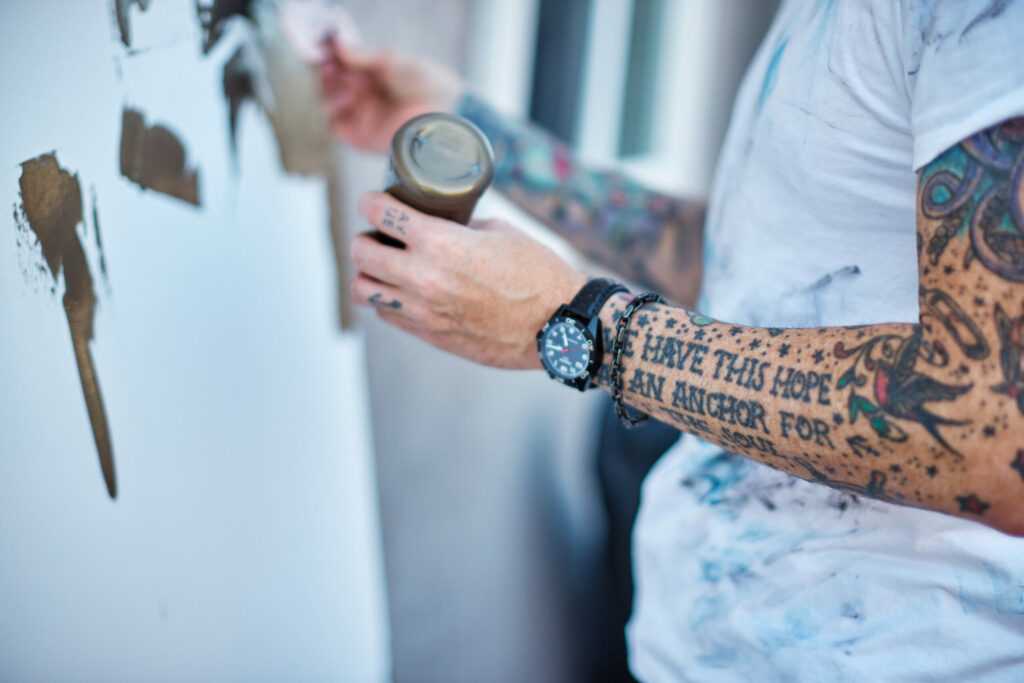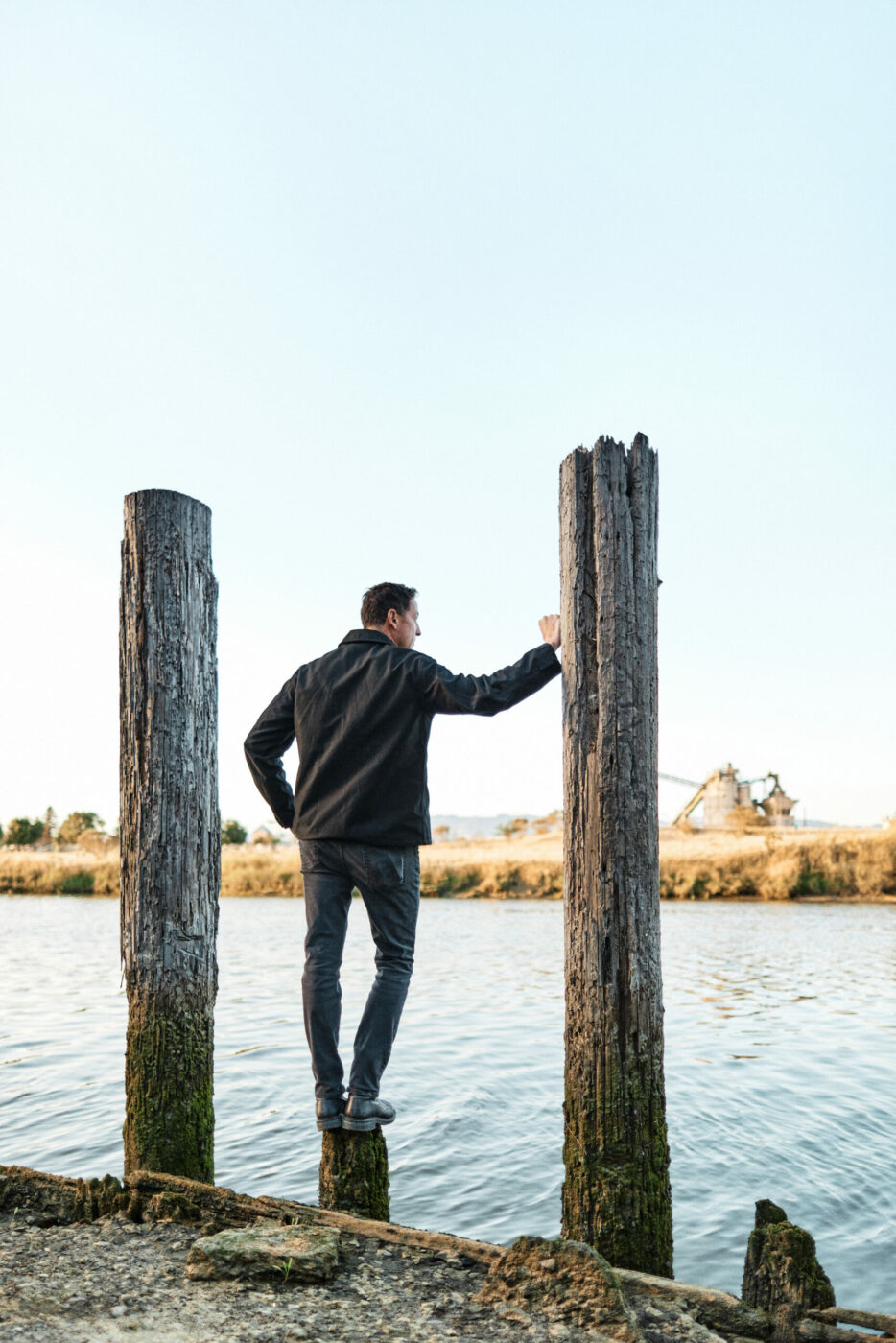From afar, Aaron Webb’s abstract paintings lure viewers in like a blurry windowpane, or a bird’s-eye view of a hazy coastline where wave break meets open sea.
But cast a brighter light, and the paintings reveal themselves in all their blemished glory. The landscape of the canvas becomes a marred universe littered with cracks, fissures, cuts, scars, scrapes and three-dimensional ridgelines that harden like scabs. From a different vantage point, hand-scrawled words like “not alone” or “the cure” sometimes emerge from the canvas.
“I love putting Easter eggs in some of these,” says Webb, his blue eyes lighting up a smile, almost daring you to find a hidden message as he props a new work up against a basketball goal in the driveway of his east Petaluma home. “Most people have no idea, even when it’s hanging on the wall. All of a sudden, they’ll turn and see it.”

On this day, he’s still readjusting to daily life after a seven-month Navy deployment in the Middle East. After preparatory training and post-operation debriefs, he was gone for a total of 15 months — so long he no longer remembers the building code to his downtown Petaluma studio. The key to his studio door isn’t working, so he opens the lock using a pocketknife he always carries.
The decompression period is always a weird liminal space, he says, not unlike his paintings.
With a foot in both worlds, he’s just started a new job in human resources at a Bay Area tech company, even as he is still processing events from this latest deployment, including the deaths of two fellow sailors. On other deployments, like during the surge of 2007-2008 in Iraq, casualties were higher. Ask him what he does in the Navy, and he remains intentionally vague, alluding to “taking care of logistics” for various units.
“I’ve seen some stuff,” he says.
Webb has spent 20 years with the Navy and continues to serve in the reserves, where he was recently promoted to master chief petty officer, one of the highest ranks for an enlisted man. He still apologizes for having “the mouth of a sailor,” and his body is tattooed with ships, tillers and cannons. One of them reads, “We Have This Hope As An Anchor For The Soul.”

He’s had experiences he’ll never forget, no matter how hard he tries. One painting came to him in a wave of tears, triggered months after a friend and fellow sailor died by suicide on Christmas Day. The loss hit Webb one day while painting in his garage, as a musical algorithm landed on a Snow Patrol song his late friend had played over and over when they were in Iraq together.
He titled the work “To Feel Finality.” As the painting runs from top to bottom, it could be the journey of a life, wading through the chaos of daily battles, scratched tally marks and what looks almost like a game of hangman, until it reaches the final third — a horizontal red line giving way to a thicker black line, the metaphor complete.
Later, in his living room, Webb nods to a work in progress hanging above a couch. The moody colors could be the gloaming at the end of the day, or maybe a silent battlefield the day after a war ends, drenched in dew and dark shadows before sunrise. It’s the first thing he’s painted after returning home.
“I put it up on the wall when I get to the point where I just need it to talk to me,” he says. “Then I sit with it and see what I need to do with it.”

Moving to the garage, where Webb builds his 6-by-8-foot wooden frames, he returns to a common theme in his paintings — the lingering sense of “decay.” As he’s talking, a tiny spider emerges from beneath the canvas of a half-finished painting and crawls along the edge. He quickly swats it with his hand, leaving a rust-colored stain.
“It’s all very organic,” he says, smiling.
Rum, sea salt, dye, ink, watercolor, latex, acrylic and detritus — they all find a home in Webb’s abstract worlds.
The titles of his paintings — like “Pull Me Out From Inside” or “The Quiet Story of Their Stars” — give hints, suggesting words for the wordless, like poetic names for experimental, instrumental jazz songs. “Sick for the Sight of You” is cloaked in painted-over, awl-engraved words. Awash in waves of turmoil, “The Dead and Dreaming” borrows from a Counting Crows lyric. And “Am I All For Nothing” bleeds in black down a 6×8-foot canvas, something that came to him while watching from home as U.S. armed forces retreated from Afghanistan, culminating with the frenzied exit at the international airport in Kabul.
He’s always dabbled in art, whether playing guitar or studying fashion design, but it wasn’t until Webb stumbled on watercolors and art supplies at a base exchange a decade ago that he seriously took up abstract painting as a way to take his mind off the chaos around him. Now, everywhere he travels with the Navy, he brings a miniature studio. Some of his fellow soldiers are intrigued and ask questions, while others could care less, he says.

Otherwise, he usually paints at home, whenever inspiration strikes, often outside along the side of his house where the sun bakes the layers of paint, and the morning dew dries and seals it in a ghostly glow. Propping the canvas on small buckets, maybe a foot off the ground, he paints flat, occasionally tilting the work at angles for inks and dyes to run through cracks between paint layers. He learned through trial and error that rum gives liquidity to dyes and inks, and sea salt crystalizes regions with thicker texture. Instead of brushes, he uses scraping tools you might find next to cans of Bondo putty at Home Depot.
Webb was raised with two older sisters in a conservative, religious household in Beaumont, Texas, an oil town 45 minutes inland from the Gulf of Mexico. Their father was a professional photographer, and Webb would spend hours in the darkroom with him, mesmerized by images coming to life in the ethereal developer solution. In high school, he was an all-state basketball player.
His painting “Drowning in the Depths of Grace,” part of his Lost at Sea series, grapples with how “church and religion played a huge part of my life growing up, but not as much now,” and how “the concept of grace is hard for people to wrap their head around.”

In August, Webb will mount a solo show at Rena Charles Gallery in Healdsburg, where owner Rena Charles was introduced to his work through a photographer she also represents. In less than a year, Charles has sold several of his paintings. One of Webb’s paintings now hangs on the wall of a prominent New York commercial real estate office; another is headed to a bed-and-breakfast in Calistoga.
“People often ask if the marks are intentional,” Charles says. “And I share that they are, and they represent the journey that you’re on, whatever that is. And I explain how Aaron shares that it’s in that in-between space – that’s the growth and those things that you learn along the way.”
Over time, Webb has come to realize maybe he doesn’t need to inflict so much pain on the paintings, gouging them with his emotions. Standing beside an older piece, he says, “I scratched it, and it works. But if I wouldn’t have done it — it’s beautiful enough and big enough that it doesn’t need it. It still communicates what it needs to, without it.”
In 2021, he was part of a group show at the National Veterans Art Museum in Chicago. But he’s wary of being pigeonholed as “a veteran artist” who might be collected and curated only into veteran art exhibits. In his eyes, he is an artist who also happens to serve his country — not exclusively a “veteran artist.” But he can’t escape who he is and where he’s been.

He also can’t escape the mixed emotions of war. “There’s not a direct tie to a bad day or something happening in the field,” he says. “It’s more like flashes and snapshots of memories and emotions that you felt — sometimes things you didn’t even know you felt, until they come back 15 years later.”
Making art is how he makes peace with himself. “This is kind of my own therapy,” he says. “I never went through art therapy. This was my own way of working through it. I just find if I create, I’m better. I have better mental health, and I’m happier.”
Once the work is done and hanging in someone else’s living room or bedroom, it no longer matters [to him] how he made peace with it.
“It took time, but now I realize it has nothing to do with me,” he says. “It’s about them and the art and what they see and what they feel.”
In that, he finds solace — knowing he’s not the only one who seeks refuge in the space between beauty and decay.
Aaron Webb’s upcoming solo show runs Aug. 15 – Sept. 30 at Rena Charles Gallery, 439 Healdsburg Ave., Healdsburg. aaronwebbstudio.com


